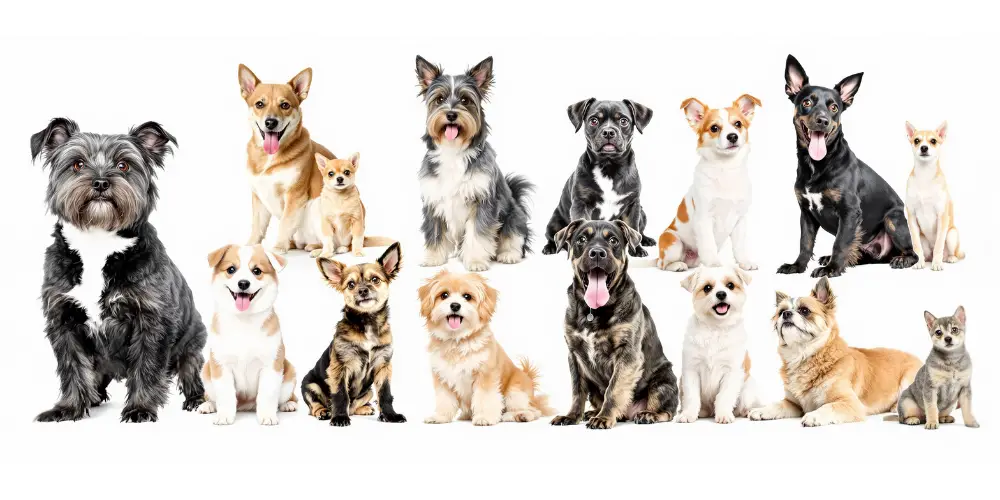Did you know that over 45% of American households with dogs have chosen small breeds? No wonder!
These compact canines offer the perfect combination of portability, adaptability, and personality.
Whether you’re living in a cozy apartment, looking for a family-friendly pet, or seeking a lower-maintenance companion in your senior years, small dogs deliver big on companionship without requiring a huge living space.
In this guide, I’ll walk you through everything you need to know about small dog breeds – from comprehensive breed profiles to comparison charts, myth-busting facts, adoption tips, and even a breed selector quiz to help you find your perfect match.
I’ve spent years working with these pint-sized pups, and I’m excited to help you discover which small breed might become your ideal furry family member!
Key Takeaways:
- Small dogs typically weigh under 20 pounds but offer varied personalities and energy levels
- Different small breeds suit different lifestyles – city dwellers, families, seniors, and active owners
- Small dogs require proper training and socialization, just like larger breeds
- Adoption offers a rewarding path to small dog ownership with many breeds available
- Finding the right match means considering temperament, exercise needs, and health factors
- Many small dogs live 15+ years, making them long-term companions deserving thoughtful selection
What Defines a “Small” Dog Breed?
When we talk about small dog breeds, what exactly do we mean?
The classification isn’t as clear-cut as you might think! Generally speaking, small dogs weigh less than 20 pounds when fully grown. But there’s actually quite a range within this category.
Small dogs typically stand under 16 inches tall at the shoulder, though height can vary significantly between breeds.
Some small breeds like Dachshunds have long bodies with short legs, while others like Italian Greyhounds have more proportional builds with longer legs relative to their body size.
Within the small dog category, we can further break things down:
- Extra-small (toy breeds): Under 10 pounds, usually 6-9 inches tall
- Small: 10-20 pounds, usually 8-16 inches tall
- Medium-small: Often called “small-medium” dogs, 20-30 pounds, typically 12-18 inches tall
The difference between these categories becomes obvious when you see them side by side. The tiny 3-pound Chihuahua looks dramatically different from a sturdy 25-pound French Bulldog, though both fall under the general “small dog” umbrella for most purposes.
According to research from the American Veterinary Medical Association, the popularity of small dogs has been steadily increasing, with more people choosing smaller breeds than ever before.
Here’s a visual breakdown of common small dog sizes:
| Size Category | Weight Range | Height Range | Examples |
|---|---|---|---|
| Extra-small/Toy | 2-10 lbs | 6-10 inches | Chihuahua, Yorkshire Terrier, Pomeranian |
| Small | 10-20 lbs | 8-16 inches | Pug, Shih Tzu, Boston Terrier |
| Medium-small | 20-30 lbs | 12-18 inches | French Bulldog, Beagle, Cocker Spaniel |
I’m always amazed by the diversity within these categories! My friend’s 4-pound Yorkie and my 18-pound Cavalier King Charles Spaniel are technically both “small” dogs, but they feel like completely different sizes when you pick them up.
[VISUAL: Size comparison chart showing silhouettes of popular small dog breeds arranged by height and weight, with a ruler for scale and everyday objects like a coffee mug for size reference | Visual size comparison of small dog breeds]
20+ Best Small Dog Breeds (with Real Owner Tips)
Looking for the perfect small companion? Here’s my roundup of the most popular and beloved small dog breeds. Each one has its own unique personality, care needs, and charm. I’ve included key details about size, temperament, and care requirements to help you find your ideal match!
Breed #1: French Bulldog
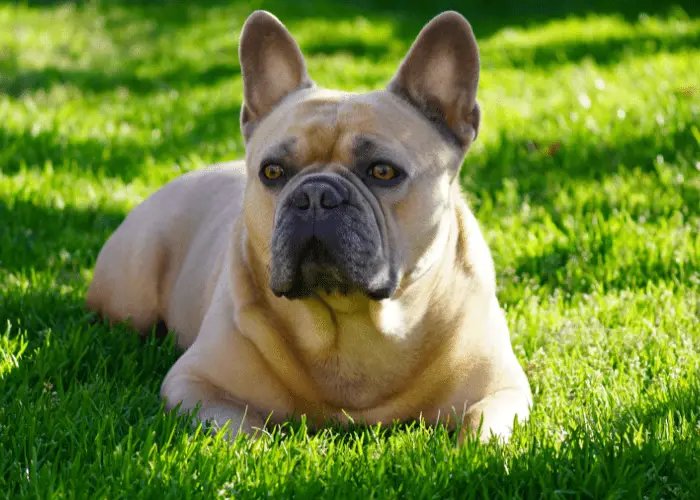
- Size: 16-28 lbs, 11-13 inches tall
- Personality/temperament: Playful, alert, adaptable, affectionate
- Energy level: Low to moderate
- Grooming requirements: Low – occasional brushing, clean facial wrinkles weekly
- Common health issues: Breathing difficulties, overheating, joint problems
- Best for: Apartments, families with older children, seniors, city dwellers
Frenchies are the perfect example of a “big dog in a small package” personality! These sturdy little bulldogs with their distinctive bat ears have skyrocketed in popularity because they’re adaptable to so many living situations. They don’t need tons of exercise, which makes them great apartment dogs, but they do love a good play session.
I absolutely love their expressive faces – those wrinkles tell you exactly what they’re thinking! Just be prepared for some snorting, snuffling, and sometimes snoring due to their flat faces.
Also worth noting – they don’t do well in hot weather because of their breathing anatomy, so they’re not the best choice if you live somewhere that gets really hot and don’t have air conditioning.
French Bulldogs make fantastic companions for city dwellers who want a small dog with minimal barking and moderate exercise needs.
Breed #2: Pomeranian
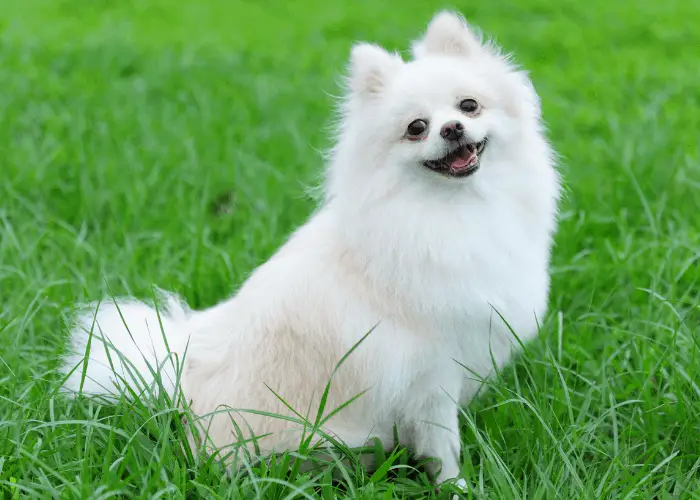
- Size: 3-7 lbs, 6-7 inches tall
- Personality/temperament: Lively, bold, curious, intelligent
- Energy level: Moderate to high
- Grooming requirements: High – regular brushing, professional grooming every 4-6 weeks
- Common health issues: Dental problems, collapsed trachea, luxating patella
- Best for: Active adults, families with older children, those looking for a small but spunky companion
Don’t let their fluffy appearance fool you! Pomeranians are descended from much larger sled-pulling breeds, and they’ve retained that bold, energetic temperament in their tiny bodies. These little furballs are known for their fox-like expression and proud personality.
I’m always impressed by how much personality fits into such a small package! Poms are surprisingly athletic and enjoy activities like short walks, indoor games, and even learning tricks.
Their beautiful double coat does require regular maintenance to prevent matting and keep it looking its best.
These tiny dynamos make excellent watchdogs (they’ll definitely let you know when someone’s at the door!) and adapt well to various living situations as long as they get enough mental and physical stimulation.
Breed #3: Cavalier King Charles Spaniel
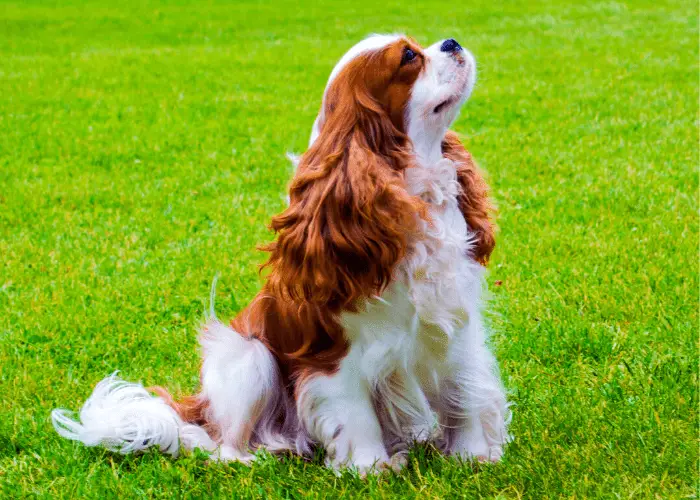
- Size: 13-18 lbs, 12-13 inches tall
- Personality/temperament: Gentle, affectionate, graceful, adaptable
- Energy level: Moderate
- Grooming requirements: Moderate – regular brushing, occasional trimming
- Common health issues: Heart problems, eye conditions, ear infections
- Best for: Families with children, seniors, first-time dog owners, multi-pet households
I often call Cavaliers the “perfect family dog” because they combine the gentleness of a toy breed with the sturdier build and playfulness of a sporting dog. Their sweet expression with those big, round eyes just melts your heart instantly!
These dogs are incredibly adaptable – they’ll happily go for a walk or play in the yard, but they’re equally content to curl up on the couch for cuddle time. They genuinely love everyone, which makes them terrible guard dogs but wonderful companions.
The Cavalier’s heart issues are something to be aware of – they’re prone to mitral valve disease, so finding a reputable breeder who does health testing is especially important. Regular vet checkups are crucial to monitor their heart health.
Breed #4: Yorkshire Terrier
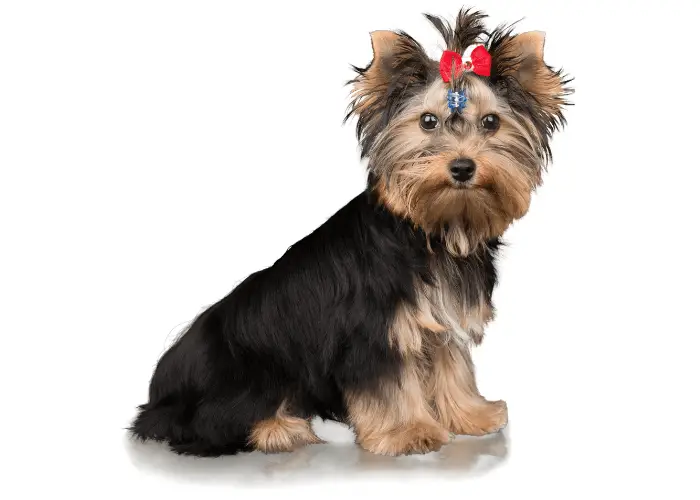
- Size: 4-7 lbs, 7-8 inches tall
- Personality/temperament: Brave, determined, energetic, affectionate
- Energy level: Moderate to high
- Grooming requirements: High – daily brushing, regular professional grooming
- Common health issues: Dental problems, collapsed trachea, liver shunt
- Best for: Active adults, those wanting a small but brave companion, households without young children
Yorkies are the perfect example of “small but mighty”! Despite their diminutive size and silky coat that makes them look like fashion accessories, these dogs are true terriers at heart – brave, occasionally stubborn, and full of personality.
Their gorgeous silky coat is actually more like human hair than fur, which means less shedding but more grooming. Many owners keep their Yorkies in a shorter “puppy cut” to make maintenance easier, though the traditional long, flowing coat is certainly stunning.
Yorkshire Terriers make excellent companions for adults and families with older children who can respect their small size. They’re surprisingly good watchdogs and will definitely alert you to anything unusual happening in your home!
Breed #5: Shih Tzu

- Size: 9-16 lbs, 9-10.5 inches tall
- Personality/temperament: Affectionate, playful, outgoing, gentle
- Energy level: Low to moderate
- Grooming requirements: High – daily brushing, regular professional grooming
- Common health issues: Breathing problems, eye issues, hip dysplasia
- Best for: Families, seniors, apartment dwellers, multi-pet households
The name “Shih Tzu” means “little lion,” but these dogs are anything but fierce! Bred specifically to be companions in Chinese palaces, they excel at their job of being lovable little friends. With their flowing double coat and sweet expression, they certainly look regal.
I love how naturally friendly these dogs are – they typically get along well with everyone, including strangers, children, and other pets. Their moderate exercise needs make them adaptable to various living situations, though their flat faces mean they don’t do well in extreme heat.
The Shih Tzu’s magnificent coat requires significant grooming commitment, so consider whether you’re up for daily brushing and regular professional grooming appointments before bringing one home.
Breed #6: Dachshund

- Size: Standard: 16-32 lbs, Miniature: 11 lbs or less; 5-9 inches tall
- Personality/temperament: Clever, brave, sometimes stubborn, devoted
- Energy level: Moderate
- Grooming requirements: Varies by coat type – smooth (low), long (moderate), wire (moderate)
- Common health issues: Back problems, obesity, dental issues
- Best for: Active adults, families with gentle older children, those wanting an entertaining companion
With their distinctive elongated bodies and short legs, Dachshunds (affectionately called “wiener dogs” or “sausage dogs”) are immediately recognizable. Originally bred to hunt badgers, these little dogs have retained their hunting instinct and brave personality.
Dachshunds come in two sizes (standard and miniature) and three coat types (smooth, long-haired, and wire-haired), giving you several options within the breed.
Their clever, sometimes mischievous personalities make them entertaining companions, though their hunting heritage can make them prone to digging and chasing small animals.
Back health is the primary concern with this breed due to their long spines. Keeping them at a healthy weight and preventing jumping from furniture is essential to protect their backs from injury.
Breed #7: Chihuahua

- Size: 2-6 lbs, 5-8 inches tall
- Personality/temperament: Loyal, sassy, alert, courageous
- Energy level: Moderate
- Grooming requirements: Low (smooth coat) to moderate (long coat)
- Common health issues: Dental problems, heart issues, patellar luxation
- Best for: Adults, seniors, those wanting a tiny but spirited companion
As the smallest recognized dog breed, Chihuahuas pack an enormous personality into a tiny body! These little dogs often form intense bonds with their owners, sometimes becoming a “one-person dog” who shows fierce loyalty to their favorite human.
Despite their diminutive size, they’re not typically fragile or delicate in temperament – many Chihuahuas seem completely unaware of how small they are! I’ve seen them confidently approach dogs ten times their size with no hesitation.
Their small size makes them extremely portable and suitable for various living situations, though they do need proper training and socialization just like any other dog. Their tendency to be vocal makes them excellent little watchdogs.
Breed #8: Boston Terrier

- Size: 12-25 lbs, 15-17 inches tall
- Personality/temperament: Friendly, bright, amusing, eager to please
- Energy level: Moderate
- Grooming requirements: Low – occasional brushing, clean facial wrinkles as needed
- Common health issues: Breathing problems, eye issues, allergies
- Best for: Families, active adults, first-time dog owners, apartment dwellers
With their tuxedo-like markings and friendly expressions, Boston Terriers have been called “American Gentlemen,” and they certainly live up to the name with their good manners and adaptable nature! These dogs strike a perfect balance between playfulness and calm companionship.
Their short coat makes grooming a breeze, though like other flat-faced breeds, they may need some attention to facial wrinkles to keep them clean and dry. They typically get along well with children and other pets, making them excellent family dogs.
Bostons are generally less noisy than many small breeds, which makes them good apartment dogs. They have moderate exercise needs that can usually be met with daily walks and some indoor play.
Breed #9: Maltese
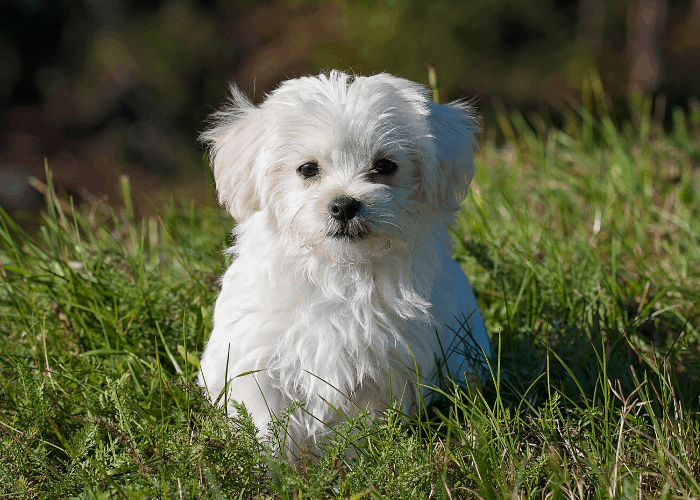
- Size: 4-7 lbs, 7-9 inches tall
- Personality/temperament: Gentle, playful, affectionate, fearless
- Energy level: Moderate
- Grooming requirements: High – daily brushing, regular professional grooming
- Common health issues: Dental problems, tear staining, liver shunt
- Best for: Adults, seniors, those willing to commit to grooming needs
The Maltese has been a companion dog for thousands of years, and they’ve perfected the art of being charming little friends! With their snow-white silky coat and dark expressive eyes, they’re absolutely beautiful dogs.
Despite their elegant appearance, Maltese are surprisingly playful and sometimes fearless. They typically form strong bonds with their owners and love being involved in all family activities. Their small size makes them portable and adaptable to different living situations.
The gorgeous white coat that makes this breed so distinctive does require significant maintenance to keep it looking its best. Many pet owners opt for a shorter “puppy cut” to reduce grooming needs while maintaining the breed’s adorable appearance.
Breed #10: Pug
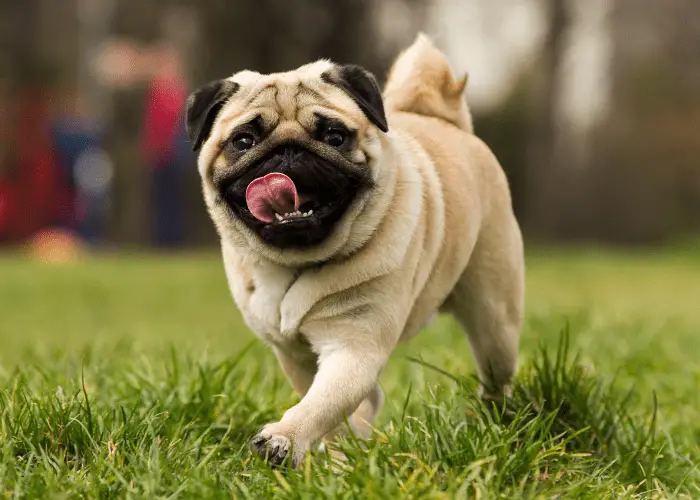
- Size: 14-18 lbs, 10-13 inches tall
- Personality/temperament: Charming, mischievous, loving, stubborn
- Energy level: Low to moderate
- Grooming requirements: Moderate – regular brushing, clean facial wrinkles
- Common health issues: Breathing problems, eye issues, obesity
- Best for: Families, seniors, apartment dwellers, multi-pet households
With their wrinkled faces and expressive eyes, Pugs have a unique appearance that many find irresistible! These dogs were bred specifically to be companions, and they excel at their job with their charming, sometimes clownish personalities.
Pugs typically love everyone they meet, making them poor guard dogs but excellent family pets. Their low to moderate exercise needs make them adaptable to various living situations, though they do enjoy short walks and play sessions.
Like other flat-faced breeds, Pugs can suffer from breathing difficulties and don’t tolerate heat well. They also tend to gain weight easily, so monitoring their food intake is important for their health.
Breed #11: Bichon Frise
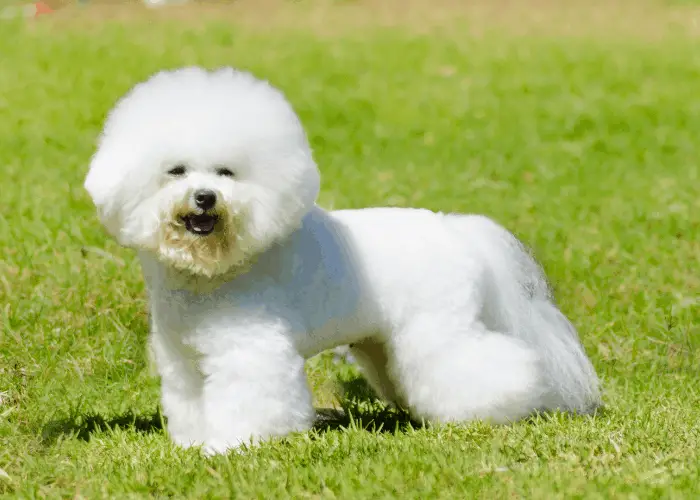
- Size: 12-18 lbs, 9.5-11.5 inches tall
- Personality/temperament: Playful, curious, affectionate, cheerful
- Energy level: Moderate
- Grooming requirements: High – regular brushing, professional grooming every 4-6 weeks
- Common health issues: Allergies, dental disease, bladder problems
- Best for: Families, allergy sufferers, apartment dwellers
The Bichon Frise looks like a living stuffed animal with its fluffy white coat and button eyes! These cheerful little dogs typically maintain their puppy-like enthusiasm well into adulthood, making them delightful companions.
One of the Bichon’s notable qualities is that they’re considered better for people with allergies than many other breeds. While no dog is truly hypoallergenic, their curly coat catches loose hair and dander, potentially reducing allergy triggers.
They’re generally good with children and other pets, making them versatile family dogs. Their moderate exercise needs can usually be met with daily walks and play sessions, and they adapt well to apartment living.
Breed #12: Miniature Schnauzer

- Size: 11-20 lbs, 12-14 inches tall
- Personality/temperament: Alert, spirited, intelligent, friendly
- Energy level: Moderate to high
- Grooming requirements: High – regular brushing, professional grooming every 6-8 weeks
- Common health issues: Diabetes, eye problems, urinary stones
- Best for: Active families, those wanting an alert, intelligent companion
With their distinctive bearded faces and alert expressions, Miniature Schnauzers stand out in the small dog crowd! These dogs were originally bred as ratters and farm dogs, so they’ve got plenty of energy and intelligence.
I love their versatility – they’re small enough for apartment living but sturdy and energetic enough for active families. They typically get along well with children and can adapt to living with other pets, especially if introduced young.
Their wiry double coat requires regular grooming to keep it looking its best, though they shed less than many other breeds, which some allergy sufferers appreciate. Regular stripping or clipping keeps their distinctive beard and eyebrows looking sharp.
Breed #13: Havanese
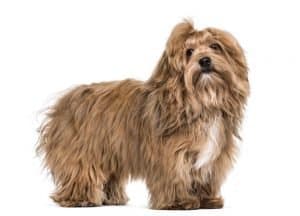
- Size: 7-13 lbs, 8.5-11.5 inches tall
- Personality/temperament: Playful, intelligent, affectionate, sociable
- Energy level: Moderate
- Grooming requirements: High – daily brushing, regular professional grooming
- Common health issues: Cataracts, deafness, liver shunt
- Best for: Families, apartment dwellers, those wanting a sociable companion
The national dog of Cuba, the Havanese is a delightful small breed with a springy gait and cheerful demeanor! These clever little dogs are natural performers who typically love learning tricks and playing games with their people.
Their silky, somewhat wavy coat comes in many colors and requires regular grooming to prevent mats and tangles. Many owners choose to keep the coat in a shorter “puppy cut” for easier maintenance, though the flowing natural coat is certainly beautiful.
Havanese are notably sociable dogs who usually get along well with everyone – children, strangers, other pets, and especially their family members. They can adapt to various living situations as long as they get plenty of human interaction.
Breed #14: Miniature Pinscher
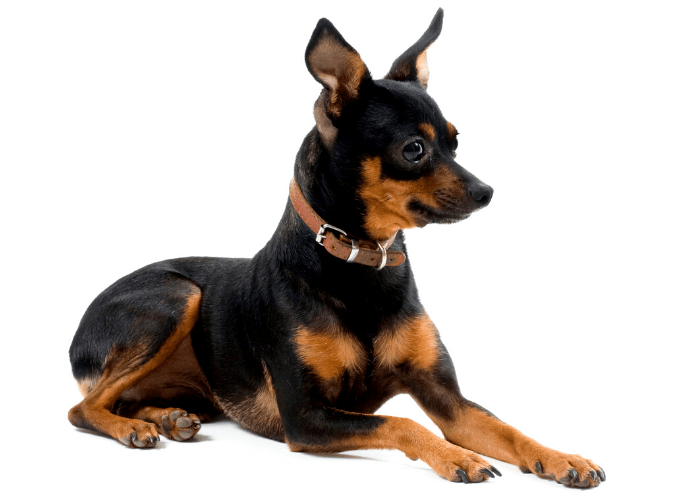
- Size: 8-10 lbs, 10-12.5 inches tall
- Personality/temperament: Fearless, energetic, alert, proud
- Energy level: High
- Grooming requirements: Low – occasional brushing
- Common health issues: Patellar luxation, Legg-Calve-Perthes disease, eye problems
- Best for: Active adults, experienced dog owners, households without very young children
Often called “King of the Toys,” the Miniature Pinscher carries himself with remarkable confidence and energy! Despite looking somewhat like a small Doberman, these dogs are actually a much older breed with a distinct heritage.
Min Pins have seemingly endless energy and a bold, fearless personality that can sometimes make them challenging for first-time dog owners. They’re extremely athletic for their size and need plenty of exercise and mental stimulation to prevent boredom.
With their short, glossy coat, Min Pins are among the easier small breeds to groom, requiring just occasional brushing. Their alertness makes them excellent watchdogs, though they can be quite vocal when they perceive something unusual.
Breed #15: Papillon
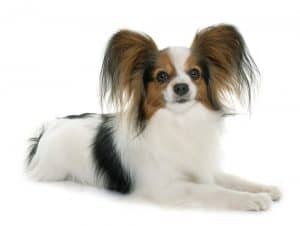
- Size: 5-10 lbs, 8-11 inches tall
- Personality/temperament: Alert, friendly, intelligent, confident
- Energy level: Moderate to high
- Grooming requirements: Moderate – brushing 2-3 times weekly
- Common health issues: Patellar luxation, dental issues, collapsed trachea
- Best for: Active adults, those interested in dog sports, households with older children
Named for their distinctive butterfly-like ears (“papillon” means butterfly in French), these elegant little dogs are actually among the most intelligent of all small breeds! Papillons frequently excel at obedience, agility, and other dog sports despite their diminutive size.
I’m always impressed by how athletic these tiny dogs are – they move with grace and energy, and they love to play and learn. Unlike some toy breeds, Papillons typically maintain their playfulness well into adulthood.
Their beautiful coat, despite its impressive appearance, actually requires less maintenance than many other long-haired breeds, needing just regular brushing rather than professional grooming. They’re adaptable dogs who can enjoy apartment living or houses with yards, as long as they get plenty of interaction and mental stimulation.
Breed #16: Jack Russell Terrier
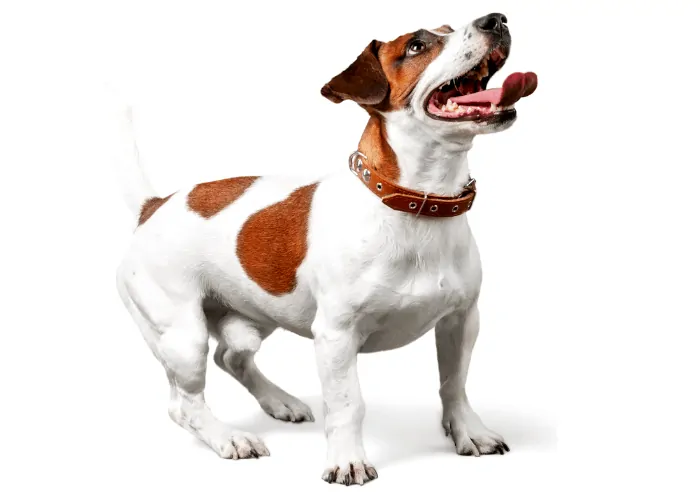
- Size: 13-17 lbs, 10-15 inches tall
- Personality/temperament: Energetic, fearless, intelligent, tenacious
- Energy level: Very high
- Grooming requirements: Low to moderate – regular brushing, occasional stripping for wire coats
- Common health issues: Deafness, eye problems, patellar luxation
- Best for: Very active owners, experienced dog owners, rural or suburban homes
When it comes to energy packed into a small package, few breeds can match the Jack Russell Terrier!
These dogs were bred to hunt foxes, and they retain their incredible stamina, fearlessness, and prey drive to this day.
I always warn potential Jack Russell owners – these are not “casual” pets! They need significant daily exercise, mental challenges, and consistent training to channel their energy appropriately. In the right active household, they’re incredibly rewarding companions who will join you for hikes, runs, and endless play sessions.
Jack Russells come in smooth, rough, and broken coat varieties, all of which are relatively easy to maintain with regular brushing. Their intelligence makes them highly trainable, though their independent terrier nature means they may sometimes have their own ideas about things!
Breed #17: Lhasa Apso
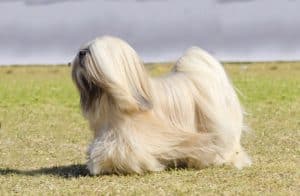
- Size: 12-18 lbs, 10-11 inches tall
- Personality/temperament: Independent, confident, loyal, somewhat aloof
- Energy level: Low to moderate
- Grooming requirements: High – daily brushing, regular professional grooming
- Common health issues: Eye problems, skin issues, kidney problems
- Best for: Adults, seniors, experienced dog owners, quieter households
Originally bred as alert watchdogs in Tibetan monasteries, Lhasa Apsos maintain their dignified, somewhat independent nature to this day. Behind that gorgeous flowing coat is a confident little dog with a mind of its own!
Unlike many small breeds that are bred specifically as companions, Lhasas are a bit more independent and sometimes aloof with strangers, though deeply loyal to their families. They make excellent watchdogs and will alert you to anything unusual.
Their stunning coat requires significant maintenance if kept long, though many pet owners opt for a shorter “puppy cut” for easier care. Despite their small size, Lhasas are sturdy dogs with a surprising lifespan, often living 15+ years.
Breed #18: Italian Greyhound
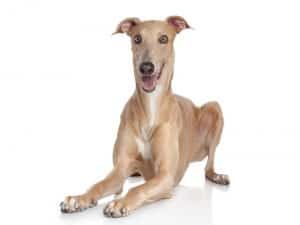
- Size: 7-14 lbs, 13-15 inches tall
- Personality/temperament: Sensitive, affectionate, athletic, gentle
- Energy level: Moderate to high, with bursts of speed
- Grooming requirements: Low – occasional brushing
- Common health issues: Dental problems, fractures, eye issues
- Best for: Adults, homes without very young children, those wanting an elegant companion
Italian Greyhounds are the smallest of the sighthounds, essentially miniature versions of their larger Greyhound cousins. With their slender build, long legs, and elegant appearance, they’re unlike most other small breeds.
These sensitive, affectionate dogs form strong bonds with their owners and often want to be right by your side (or in your lap). Despite their delicate appearance, they can be surprisingly athletic, with impressive bursts of speed during play.
Their short, fine coat makes grooming a breeze, though they do get cold easily and often appreciate sweaters in chilly weather. Their thin skin and slender bones mean they need gentle handling and aren’t ideal for households with very young children.
Breed #19: Coton de Tulear
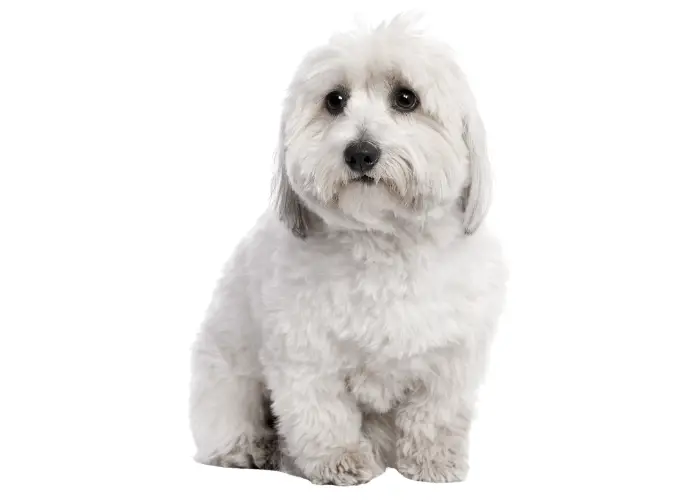
- Size: 8-15 lbs, 9-11 inches tall
- Personality/temperament: Happy, cuddly, playful, sociable
- Energy level: Moderate
- Grooming requirements: High – daily brushing, regular professional grooming
- Common health issues: Hip dysplasia, eye problems, dental issues
- Best for: Families, singles, seniors, nearly any household wanting a joyful companion
Named for their cotton-like coat and Tulear (a city in Madagascar), these charming little dogs are relatively uncommon but gaining popularity due to their wonderful temperaments! Cotons are known for their happy, sociable nature and tendency to form strong bonds with their people.
Their gorgeous white (or partially colored) coat does require significant maintenance to prevent matting, though many owners say their sweet personalities make the grooming effort worthwhile. Despite their small size, they’re relatively sturdy dogs who generally get along well with children and other pets.
Cotons typically adapt well to various living situations and activity levels. They enjoy walks and play sessions but aren’t as high-energy as some small breeds, making them versatile companions for different lifestyles.
Breed #20: Brussels Griffon
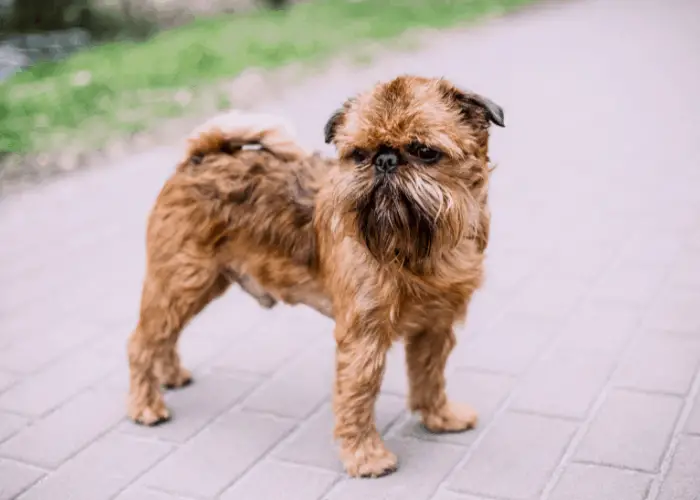
- Size: 8-10 lbs, 7-8 inches tall
- Personality/temperament: Sensitive, comical, affectionate, alert
- Energy level: Moderate
- Grooming requirements: Moderate to high – depends on coat type (rough or smooth)
- Common health issues: Eye problems, respiratory issues, patellar luxation
- Best for: Adults, experienced dog owners, households without very young children
With their almost human-like expressions and bearded faces, Brussels Griffons certainly stand out in the small dog crowd! These distinctive little dogs come in rough (wiry) and smooth coat varieties, each with their own grooming needs.
Griffons typically form intense bonds with their owners and can be sensitive to changes in routine or mood. They’re known for their expressive faces and sometimes comical antics, making them entertaining companions.
Despite their small size, they’re generally sturdy little dogs, though they can be somewhat sensitive to rough handling and aren’t always the best choice for homes with very young children. They make excellent apartment dogs due to their moderate exercise needs and compact size.
[VISUAL: Photo grid showing representative examples of each breed in a standard pose, with consistent lighting and scale to allow for visual comparison | Gallery of the 20 most popular small dog breeds]
Small Dog Breeds Comparison Table: At-a-Glance Guide
Choosing the right small dog can feel overwhelming with so many wonderful options! Here’s a quick comparison chart to help you narrow down your choices based on key factors like weight, shedding, barking tendency, kid-friendliness, and lifespan.
| Breed | Weight | Shedding Level | Barking Tendency | Kid-Friendly | Life Expectancy |
|---|---|---|---|---|---|
| French Bulldog | 16-28 lbs | Low | Low | Moderate | 10-12 years |
| Pomeranian | 3-7 lbs | Moderate | High | Moderate | 12-16 years |
| Cavalier King Charles Spaniel | 13-18 lbs | Moderate | Low | High | 10-14 years |
| Yorkshire Terrier | 4-7 lbs | Low | Moderate-High | Moderate | 13-16 years |
| Shih Tzu | 9-16 lbs | Low | Moderate | High | 10-16 years |
| Dachshund | 11-32 lbs | Moderate | Moderate-High | Moderate | 12-16 years |
| Chihuahua | 2-6 lbs | Low-Moderate | High | Low-Moderate | 14-16 years |
| Boston Terrier | 12-25 lbs | Low | Low-Moderate | High | 11-13 years |
| Maltese | 4-7 lbs | Low | Moderate | Moderate | 12-15 years |
| Pug | 14-18 lbs | High | Low | High | 12-15 years |
| Bichon Frise | 12-18 lbs | Low | Moderate | High | 14-15 years |
| Miniature Schnauzer | 11-20 lbs | Low | High | High | 12-15 years |
| Havanese | 7-13 lbs | Low | Moderate | High | 14-16 years |
| Miniature Pinscher | 8-10 lbs | Low | High | Moderate | 12-16 years |
| Papillon | 5-10 lbs | Moderate | Moderate | Moderate | 14-16 years |
| Jack Russell Terrier | 13-17 lbs | Moderate | High | Moderate | 13-16 years |
| Lhasa Apso | 12-18 lbs | Low | Moderate | Low-Moderate | 12-15 years |
| Italian Greyhound | 7-14 lbs | Low | Low-Moderate | Low-Moderate | 14-15 years |
| Coton de Tulear | 8-15 lbs | Low | Low-Moderate | High | 15-19 years |
| Brussels Griffon | 8-10 lbs | Low | Moderate | Moderate | 12-15 years |
This table gives you a quick overview, but remember that individual dogs within each breed can vary! According to research published in the Journal of Veterinary Behavior, factors like early socialization and training often have a bigger impact on a dog’s behavior than breed alone.
Find Your Ideal Small Dog Breed: Interactive Quiz
Not sure which small breed is right for your lifestyle? Take this quick quiz to help narrow down your options! For each question, select the answer that best describes your preferences and lifestyle. At the end, you’ll see which small breeds might be your perfect match.
Which Small Dog Breed is Right for You?
Remember, this is just a starting point! I recommend meeting several breeds in person before making your final decision. Each dog is an individual with their own unique personality beyond breed tendencies. According to the American Kennel Club, meeting adult dogs of your chosen breed can give you a good idea of what to expect when your puppy grows up.
[VISUAL: Flowchart showing the quiz pathway with cute illustrations of different small breed dogs at the end points | Small dog breed selector quiz visualization]
Best Small Dogs for Every Need
Different lifestyles call for different dog traits! Here’s a breakdown of the best small breeds for specific situations and households.
Best Small Dogs for Apartments
Living in an apartment doesn’t mean you can’t have a dog! These breeds adapt particularly well to apartment living due to their size, noise level, and exercise needs:
- French Bulldog: These sturdy little bulldogs are typically quiet (rarely barking), have moderate exercise needs that can be met with short walks, and their friendly, adaptable nature makes them perfect for apartment living. They’re content to lounge around most of the day but still enjoy play sessions and walks.
- Shih Tzu: Bred specifically to be palace companions, Shih Tzus adapt beautifully to indoor living. Their exercise needs can be met with short daily walks and indoor play. They’re not typically excessive barkers, which your neighbors will appreciate!
- Boston Terrier: The “American Gentleman” makes an excellent apartment dog with moderate exercise needs and a generally quiet demeanor. Their friendly, adaptable personality helps them adjust to various living situations, and they’re sturdy enough to handle stairs or elevator rides.
- Cavalier King Charles Spaniel: These gentle dogs are adaptive to your lifestyle – they’ll happily join you for walks or play in the yard, but they’re equally content to curl up on the couch. Their typically quiet nature makes them good neighbors in close quarters.
- Maltese: Despite their elegant appearance, Maltese are surprisingly adaptable to apartment living. They need regular exercise but not extensive outdoor time, and their small size means even their playtime can be accommodated indoors.
When choosing an apartment dog, temperament and training matter more than breed alone! Any dog can become a barker if not properly trained and exercised, regardless of breed. I’ve lived in apartments with several different small breeds, and proper exercise and mental stimulation were always the keys to having a happy, quiet dog.
Best Hypoallergenic Small Dogs
While no dog is truly 100% hypoallergenic (according to research from the American Academy of Allergy, Asthma & Immunology), these breeds tend to produce fewer allergens and might work better for people with mild to moderate allergies:
- Bichon Frise: With their curly coat that traps loose hair and dander, Bichons are often recommended for allergy sufferers. Their cheerful, friendly temperament makes them wonderful companions for families, and they adapt well to various living situations.
- Maltese: The Maltese’s silky, hair-like coat produces less dander than many breeds, and they don’t shed much. These affectionate, playful dogs make loyal companions for those willing to keep up with their grooming needs.
- Yorkshire Terrier: Yorkies have hair rather than fur, which means less shedding and dander production. Their brave, spirited personality belies their small size, making them entertaining companions for those with allergies.
- Miniature Schnauzer: The wiry coat of the Miniature Schnauzer tends to trap allergens rather than releasing them into the environment. These intelligent, alert dogs make excellent watchdogs while also being affectionate family companions.
- Havanese: The Havanese’s silky coat sheds very little, potentially reducing allergen spread throughout the home. These cheerful, sociable dogs love learning tricks and playing games with their people.
If you have allergies, I recommend spending time with any breed before bringing one home permanently. Individual reactions vary greatly, and what works for one allergy sufferer might not work for another. My cousin with moderate dog allergies does fine with her Bichon but still reacts to my Cavalier!
Best Small Dogs for Families with Kids
Finding a dog that’s good with children means looking for patience, sturdiness, and a forgiving temperament. These breeds typically excel with kids:
- Cavalier King Charles Spaniel: Perhaps the perfect family dog, Cavaliers combine gentle temperament with enough sturdiness to handle gentle play with children. They’re typically patient, affectionate, and eager to participate in family activities.
- Boston Terrier: The sturdy build, playful nature, and typically patient temperament of Boston Terriers make them excellent family dogs. They have enough energy to play with kids but aren’t so high-energy that they become overwhelming.
- Beagle: While at the upper end of the “small” category, Beagles are famously good with children. Their sturdy build, patient nature, and love of play make them natural companions for active kids. Just be prepared for their vocal nature!
- Coton de Tulear: These cheerful, sturdy little dogs typically love children and have the patience to handle the sometimes unpredictable nature of kids. Their happy, adaptable temperament fits well into family life.
- Miniature Schnauzer: Robust enough for play yet small enough to be manageable, Miniature Schnauzers typically excel in family settings. Their protective nature makes them look out for their young family members, and they’re generally patient with children.
No matter which breed you choose, always supervise interactions between dogs and young children, and teach children how to respectfully interact with dogs. I’ve found that teaching kids to respect a dog’s space and read basic dog body language creates harmony in households with both two-legged and four-legged children!
Best Small Dogs for Seniors
For older adults, these breeds offer companionship without requiring excessive exercise or strength to handle:
- Maltese: These gentle companions adapt well to a relaxed lifestyle and don’t require strenuous exercise. Their affectionate nature makes them wonderful companions for seniors seeking a lap dog, though their grooming needs should be considered.
- Shih Tzu: Bred specifically to be companions, Shih Tzus excel at their job! They’re typically content with moderate exercise and love nothing more than being near their people. Their friendly nature makes them good companions for seniors who receive visitors.
- Cavalier King Charles Spaniel: These gentle, adaptable dogs adjust their energy level to match yours, making them perfect for seniors who want a dog that can either take a leisurely walk or spend a quiet day at home. Their affectionate nature provides wonderful companionship.
- French Bulldog: While they require minimal grooming and exercise, Frenchies offer maximum companionship! Their generally calm demeanor and moderate exercise needs make them manageable for seniors, though their potential health issues should be considered.
- Pug: These charming little dogs typically love nothing more than being with their people. Their moderate exercise needs can be met with short walks, and their affectionate, sometimes comical nature provides both companionship and entertainment.
When choosing a dog for a senior, it’s important to consider not just the present but the future. A slightly older dog (perhaps 2-4 years) might be perfect, as they’re typically past the more demanding puppy stage but still have many years of companionship to offer.
Small Dogs That Bark the Least
For those in apartments or who simply prefer a quieter companion, these breeds tend to be less vocal:
- French Bulldog: Frenchies are known for being relatively quiet dogs who communicate more through grunts, snorts, and other amusing noises than barking. They’ll still alert you to visitors but aren’t typically nuisance barkers.
- Cavalier King Charles Spaniel: These gentle dogs are generally quiet, saving their barks for when they truly feel something needs your attention. Their sweet temperament doesn’t include the watchdog-style barking common in many small breeds.
- Pug: Pugs are more likely to snort and snuffle than to bark excessively. They’re typically quiet dogs who prefer to observe the world with their expressive eyes rather than comment on it vocally.
- Shih Tzu: While they’ll certainly let you know if someone’s at the door, Shih Tzus aren’t typically yappy dogs. Their palace dog heritage seems to have given them a more dignified approach to communication than some other small breeds.
- Italian Greyhound: These sensitive, elegant dogs aren’t known for excessive barking. They’re typically quiet companions who save their voices for important communications.
I should note that proper training and adequate exercise can significantly reduce barking in any breed. Even breeds known for being vocal can learn appropriate barking behavior with consistent training and having their exercise and mental stimulation needs met.
Myths About Small Dog Breeds: Busted
Small dogs sometimes get a bad rap based on stereotypes and misconceptions. Let’s set the record straight on some of the most common myths!
Myth 1: “Small dogs don’t need exercise”
This couldn’t be further from the truth! While small dogs may need less exercise than, say, a Border Collie, they still require regular physical activity for their physical and mental health. Some small breeds like Jack Russell Terriers and Miniature Pinschers have energy levels that would exhaust a marathon runner!
The “apartment dog” label often mistakenly suggests low exercise needs, but it actually refers to space requirements, not activity levels. According to veterinary behaviorist Dr. Karen Overall from the University of Pennsylvania School of Veterinary Medicine, “Small dogs that don’t receive adequate exercise often develop behavior problems like excessive barking, destructiveness, and anxiety.”
Most small breeds need at least 30 minutes of activity daily, and many need significantly more. Exercise requirements vary by breed, age, and individual temperament – a young Jack Russell needs much more exercise than a senior Shih Tzu.
Myth 2: “Small dogs are easier to train”
This myth seems logical – smaller dogs should be easier to control, right? In reality, training has much more to do with breed traits, individual temperament, and consistent training methods than size.
Some small breeds were developed to work independently (like terriers hunting vermin), which can translate to a stubborn streak. Others were bred purely as companions and may not have the working drive that makes some breeds eager to please.
Dr. James Serpell, professor of Animal Ethics at the University of Pennsylvania School of Veterinary Medicine, notes: “Many small breeds are actually quite intelligent but may appear ‘untrainable’ because owners don’t invest the same effort in training that they would with larger dogs where behavior problems could be more dangerous.”
Small dogs require the same consistent, positive training methods as larger breeds. The difference is that many owners inadvertently reward or tolerate behaviors in small dogs (like jumping up) that they would correct in larger dogs.
Myth 3: “Small dogs are aggressive”
The myth of the “angry small dog” is perhaps the most pervasive stereotype about small breeds. You’ve probably heard terms like “small dog syndrome” or “Napoleon complex” to describe seemingly aggressive small dogs.
Certified dog trainer Sarah Hodgson explains: “What people perceive as aggression in small dogs is often fear-based behavior. From their perspective, the world is much bigger and potentially scarier. Without proper socialization and training, small dogs may resort to defensive behaviors because they feel vulnerable.”
According to a study in the Journal of Veterinary Behavior, owner behavior significantly impacts small dog behavior – owners who carry their small dogs frequently and don’t provide proper socialization report more aggression and fear-based behaviors.
The reality is that aggression has more to do with training, socialization, and individual temperament than size. Proper socialization from puppyhood, consistent training, and treating small dogs like dogs (rather than babies) prevents many behavior problems.
Myth 4: “Small dogs are all lapdogs”
While many small breeds do enjoy cuddling, assuming all small dogs are natural lapdogs oversimplifies their diverse temperaments and histories. Many small breeds were developed for working roles, not just companionship!
Terrier breeds like Yorkshire Terriers and Jack Russells were bred to hunt vermin. Dachshunds were developed to flush badgers from their dens. Miniature Pinschers were alert watchdogs and ratters. These working backgrounds influence their modern personalities.
Veterinary behaviorist Dr. Christopher Pachel notes: “Even breeds now kept primarily as companions retain the traits they were selected for historically. A Yorkshire Terrier may look like a glamorous lapdog, but they still have the bold, tenacious temperament that made them excellent ratters in textile mills.”
While many small dogs enjoy cuddle time, most also need appropriate outlets for their energy and natural behaviors. Even the most dedicated lapdog breeds benefit from regular exercise, mental stimulation, and the opportunity to just be dogs!
Videos: See Popular Small Breeds in Action
Sometimes seeing is believing! Check out these short video clips to get a better sense of how different small breeds behave in various situations.
Small Dogs Playing
This short video shows several small breeds enjoying playtime, demonstrating their different play styles and energy levels. Notice how the Jack Russell moves with incredible speed and agility, while the French Bulldog has a more grounded, muscular play style.
Training Small Breeds
Watch as these small dogs demonstrate their impressive trainability! From the highly focused Papillon performing agility to the clever Bichon Frise learning new tricks, this clip proves that small dogs can excel at training with the right methods.
Small Dogs as Family Companions
This heartwarming footage shows small breeds interacting with family members of all ages. Note the gentle patience of the Cavalier with the toddler and the playful energy of the Boston Terrier with older children.
Small Dogs in Apartment Living
See how these small breeds adapt to apartment living! This clip shows various small dogs demonstrating indoor exercise games, relaxing in apartment settings, and enjoying urban walks on leash.
These videos help illustrate the distinctive personalities and characteristics of different small breeds, giving you a better sense of which might fit your lifestyle and preferences.
Adopting vs. Buying a Small Dog: What to Know
Adding a small dog to your family is an exciting decision, but how you acquire your new companion matters. Let’s explore the options of adoption versus purchasing from a breeder.
Why Adopt a Small Breed?
Adoption offers numerous benefits for both you and the dog. Here are some compelling reasons to consider adoption:
- Save a life: Each year, millions of dogs end up in shelters, and adopting means giving a deserving dog a second chance at a loving home.
- Know what you’re getting: Adult rescue dogs have established personalities, so you’ll have a better idea of how they’ll fit into your lifestyle compared to a puppy whose adult traits are still developing.
- Skip the puppy stage: While puppies are adorable, they’re also a lot of work! An adult dog may already be housetrained and know basic commands.
- Cost-effective: Adoption fees are typically much lower than breeder prices and usually include initial veterinary care like vaccinations, microchipping, and spaying/neutering.
- Feel good factor: There’s something incredibly rewarding about knowing you’ve given a homeless dog a loving forever home.
Small breeds are highly sought after in shelters and often get adopted quickly, so you might need to be patient and persistent in your search. Setting up alerts on adoption websites and developing relationships with local rescue organizations can help you find your perfect match.
How to Find Breed-Specific Rescues
If you have your heart set on a particular small breed, breed-specific rescue organizations can be an excellent resource:
- National breed clubs: Most recognized breeds have national clubs that either run rescue programs or can direct you to reputable rescue organizations. For example, the Yorkshire Terrier Club of America operates a rescue network specifically for Yorkies.
- Online rescue databases: Websites like Petfinder and Adopt-a-Pet allow you to search for specific breeds within your geographical area.
- Social media groups: Many breed-specific rescues maintain active Facebook pages or groups where they post available dogs and success stories.
- Local shelters and all-breed rescues: While not breed-specific, many shelters and rescues get small breeds regularly. Building relationships with staff and letting them know what you’re looking for can help, as they may contact you when your preferred breed arrives.
- Small dog rescues: Some rescue organizations specialize in small breeds in general rather than specific breeds. These can be excellent resources for finding various small dogs.
When working with rescues, be prepared to complete an application process and possibly undergo a home check. While this might seem invasive, it’s a good sign that the rescue cares about finding appropriate, permanent homes for their dogs.
When Purchasing Makes Sense
While adoption is a wonderful option, there are legitimate reasons why some people choose to purchase from a reputable breeder:
- Specific needs: If you need a dog for a specific purpose (like a therapy dog with very particular temperament requirements) or have specific health concerns that require knowing the dog’s genetic background.
- Predictability: Purebred puppies from reputable breeders tend to have more predictable physical and behavioral traits, which can be important for some families.
- Raising from puppyhood: Some people specifically want the experience of raising a dog from puppyhood and shaping their early experiences.
If you decide to purchase, doing so responsibly is crucial. This means:
- Finding truly reputable breeders: Look for breeders who health test their dogs, prioritize temperament and health over appearance, provide early socialization, and care deeply about where their puppies go.
- Visiting in person: Never purchase a puppy sight unseen or have one shipped to you. Visit the breeding facility to see how the dogs live and meet at least the mother dog.
- Asking questions: Reputable breeders welcome questions about health testing, socialization, and their breeding program. They should also ask you plenty of questions to ensure their puppies go to appropriate homes.
- Avoiding puppy mills and pet stores: These operations prioritize profit over welfare and contribute to animal suffering. Pet store puppies almost always come from puppy mills, regardless of what the store claims.
The most important thing is making an informed decision that’s right for both your family and the dog you bring home.
FAQs About Small Dog Breeds
As you consider adding a small dog to your family, you probably have questions. Here are answers to some of the most commonly asked questions about small breeds.
What’s the calmest small dog breed?
If you’re looking for a laid-back small companion, consider these naturally calmer breeds:
- Cavalier King Charles Spaniel: These gentle dogs adapt to your lifestyle and are typically content whether going for a walk or relaxing at home. Their sweet temperament makes them one of the calmest small breeds.
- Shih Tzu: Bred specifically as companion dogs for Chinese royalty, Shih Tzus generally have moderate energy levels and enjoy relaxing with their people after short play sessions or walks.
- French Bulldog: These charming bulldogs typically have moderate to low energy levels and are content with short bursts of play followed by plenty of lounging. Their laid-back nature makes them excellent apartment dogs.
- Pug: Known for their charming, sometimes lazy personalities, Pugs are typically content with moderate exercise and plenty of nap time. They’re generally easygoing companions who adapt well to various lifestyles.
- Japanese Chin: Less common than some other breeds, these elegant little dogs were bred as companions for Japanese nobility and typically have a calm, almost cat-like demeanor that makes them excellent apartment dogs.
Individual temperament varies even within breeds, so meeting the specific dog you’re considering is always important. Age is also a factor – most dogs become calmer as they mature beyond the puppy and adolescent stages.
Which small dog breeds are easiest to train?
Some small breeds are renowned for their trainability:
- Papillon: Often ranking among the most intelligent of all dog breeds, Papillons typically excel at obedience and other training. Their eager-to-please nature and focus make them highly trainable despite their tiny size.
- Miniature Schnauzer: These intelligent little dogs are typically eager to learn and respond well to consistent, positive training methods. Their working heritage gives them a strong desire to please their owners.
- Havanese: Known for their problem-solving abilities and desire to please, Havanese are generally very trainable dogs who excel at learning tricks and commands. Their playful nature makes training sessions enjoyable for both dog and owner.
- Cavalier King Charles Spaniel: The Cavalier’s gentle, eager-to-please nature makes them highly trainable companions who typically respond well to positive reinforcement methods. They’re usually eager to learn new things to please their people.
- Boston Terrier: Intelligent and typically eager to please, Boston Terriers respond well to consistent, positive training methods. Their desire for human approval makes them generally willing students.
According to certified dog trainer Victoria Stilwell, “Small breeds can be just as trainable as larger dogs, but training must be consistent and use positive reinforcement methods. Many people make the mistake of not training small dogs as thoroughly as they would larger breeds, which creates behavior problems.”
What are the healthiest small dog breeds?
While all breeds have some health concerns, these small breeds often enjoy good overall health and longevity:
- Havanese: These sturdy little dogs typically have fewer breed-specific health issues than many other small breeds and often live 14-16 years. Their moderate build without extreme physical features contributes to their general good health.
- Miniature Schnauzer: With fewer genetic health problems than many small breeds, Miniature Schnauzers often live long, healthy lives of 12-15 years. They’re less prone to some of the structural issues that affect other small breeds.
- Bichon Frise: These cheerful dogs typically enjoy relatively good health and longevity, often living 14-15 years. They don’t have as many of the structural issues (like extremely flat faces) that can cause health problems in some small breeds.
- Shiba Inu: At the upper end of the small dog category, Shibas are generally hardy dogs with few breed-specific health issues. Their natural build without exaggerated features contributes to their overall good health.
- Border Terrier: These sturdy little terriers typically have fewer health issues than many small breeds and often live 12-15 years. Their moderate build and lack of exaggerated features contribute to their general hardiness.
Dr. Sarah Johnson, veterinarian at Tufts University Veterinary Medical Center, notes:
“The healthiest small dogs tend to be those with moderate physical features – not extremely tiny, not extremely short-faced, and not extremely long-backed. Extremes in physical structure often lead to health problems.”
Remember that proper care significantly impacts any dog’s health. Regular veterinary care, appropriate diet, adequate exercise, and dental care all contribute to a dog’s overall health and longevity regardless of breed.
How much does it typically cost to own a small dog?
While small dogs generally cost less to feed than larger breeds, responsible dog ownership involves various expenses:
Initial costs:
- Adoption fee or purchase price: $50-$300 (shelter adoption) to $500-$5,000+ (breeder)
- Initial veterinary visit: $100-$300
- Spay/neuter (if not included in adoption): $200-$500
- Initial supplies (bed, crate, collar, leash, toys): $200-$500
Annual costs:
- Food: $200-$600 (premium food for a small dog)
- Routine veterinary care: $200-$500
- Preventative medications (flea, tick, heartworm): $100-$300
- Grooming (varies widely by breed): $0-$1,000
- Licensing: $10-$50
- Toys, treats, and miscellaneous: $100-$300
Potential additional costs:
- Pet insurance: $200-$800 annually
- Professional training: $100-$1,000+
- Pet sitting or boarding: $15-$50 per day
- Emergency veterinary care: Potentially thousands of dollars
Dr. Peter Williams, veterinary economist, explains: “While the day-to-day costs of small dogs are generally lower than for large breeds, responsible ownership still requires a significant financial commitment. The greatest variables are typically healthcare costs, which can be unpredictable, and grooming costs, which vary dramatically between breeds.”
Planning for the lifetime cost of dog ownership, which can range from $15,000 to $30,000+ over the dog’s life, is an important part of responsible pet ownership.
Do small dogs live longer than larger breeds?
Yes, small dogs typically live longer than larger breeds, a phenomenon well-documented in veterinary research.
According to a study published in The American Naturalist, smaller dogs tend to age more slowly and have longer average lifespans than larger dogs.
Small breeds often live 12-16 years, with many individuals reaching 17-20 years of age. Medium to large breeds typically live 10-14 years, while giant breeds often have lifespans of just 8-10 years.
Dr. Kate Creevy, veterinary researcher at the University of Georgia, explains: “The relationship between size and lifespan in dogs is one of the most robust across the animal kingdom, but interestingly, it’s reversed from what we see in other mammals, where larger species generally live longer than smaller ones.”
The reasons for this size-lifespan relationship aren’t fully understood, but theories include:
- Larger dogs age more rapidly, with accelerated growth potentially leading to earlier onset of age-related diseases
- Increased body mass may create greater oxidative stress in larger dogs
- Specific growth factors that increase size may also affect aging processes
This longer lifespan is an important consideration when choosing a small dog – you’re potentially making a 15+ year commitment to your canine companion!
How can I socialize my small dog with larger dogs safely?
Socialization between small and large dogs requires careful management to ensure safety:
- Start with known, calm larger dogs: Begin socialization with larger dogs you know to be gentle and well-mannered. This builds positive experiences and confidence.
- Use controlled environments: Initial meetings should occur in neutral territory with both dogs on leash. Gradually progress to off-leash interactions in secure areas as appropriate.
- Supervise all interactions: Never leave small and large dogs unsupervised, regardless of how well they seem to get along. Size differences alone create potential risks.
- Learn to read dog body language: Understanding subtle signs of stress, fear, or overexcitement helps you intervene before problems develop.
- Allow the small dog to set the pace: Some small dogs are confident around larger dogs, while others need more time to build comfort. Respect your dog’s comfort level.
Certified dog trainer Maria Sullivan advises: “Small dogs should never be forced to interact with larger dogs if they’re showing fear. However, avoiding all interaction with larger dogs can reinforce fear. The key is creating positive, controlled experiences that build confidence over time.”
Many dog daycare facilities and training centers offer small dog playgroups, which can be an excellent way for your small dog to build social skills in an appropriately matched environment before gradually introducing larger dog interactions.
Conclusion
Small dog breeds offer incredible diversity, adaptability, and companionship in compact packages.
Whether you’re looking for an energetic little terrier to join your active lifestyle or a gentle lap dog to provide quiet companionship, there’s likely a small breed that fits your life perfectly.
Throughout this guide, we’ve explored the wonderful variety of small dogs – from playful Papillons to sturdy French Bulldogs, elegant Italian Greyhounds to spirited Jack Russells.
Each breed brings its own unique combination of physical traits, personality characteristics, and care needs.
What matters most isn’t a dog’s size but finding the right match between your lifestyle and the dog’s needs. When properly trained, socialized, and cared for, small dogs reward their owners with years of loyalty, affection, and joy.
The American Kennel Club notes that small dogs often live significantly longer than larger breeds, with many small breeds regularly reaching 14-16 years of age or beyond.
This means your commitment to a small dog is likely to be a long-term relationship that deserves thoughtful consideration from the start.
If you’re considering adding a small dog to your family, I encourage you to:
- Research thoroughly beyond just appearance
- Meet several dogs of your chosen breed
- Consider adoption from shelters or breed rescues
- Prepare your home for your new companion
- Commit to proper training and socialization
Take our breed selector quiz to help narrow down which small breed might be your perfect match, and remember that whichever small breed you choose, you’re embarking on a relationship that will bring years of companionship, laughter, and love to your life.
The best things really do come in small packages—especially when those packages have four paws and wagging tails!

